It looks like you're using an Ad Blocker.
Please white-list or disable AboveTopSecret.com in your ad-blocking tool.
Thank you.
Some features of ATS will be disabled while you continue to use an ad-blocker.
3
share:
Maybe I'm the last one to know this, but I was looking at Rigil Kent (4.39 LY) and went back to 3115 BC just to see where it
was. I started at 2012 and worked my way back; I know stellarium.org... is just a computer simulation and this could just be a glitch, but I was
watching the screen and I'll be damned if Rigil Kent didn't split in 2 right before my eyes.
Now I am sure I will be told by someone how big a moron I am, but oh well...I took some pictures to share.
a2 Cen 12-20-12 (from the Earth)...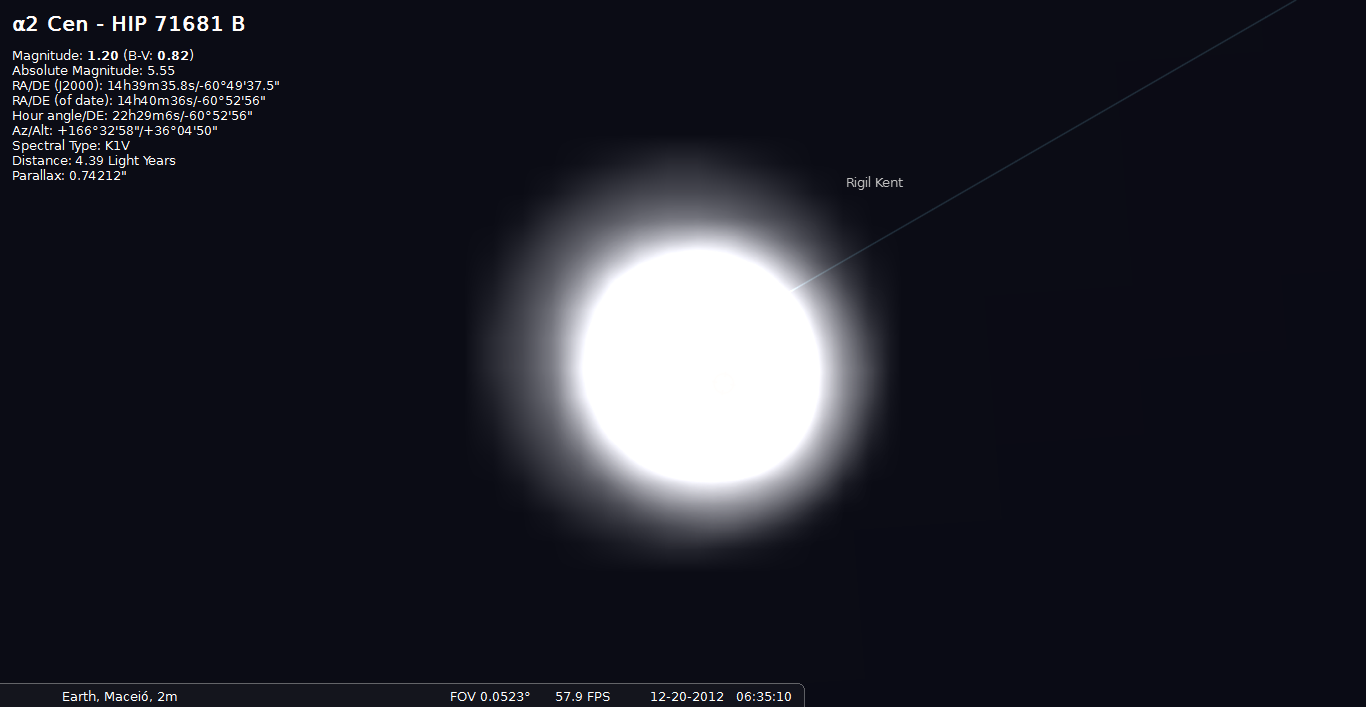
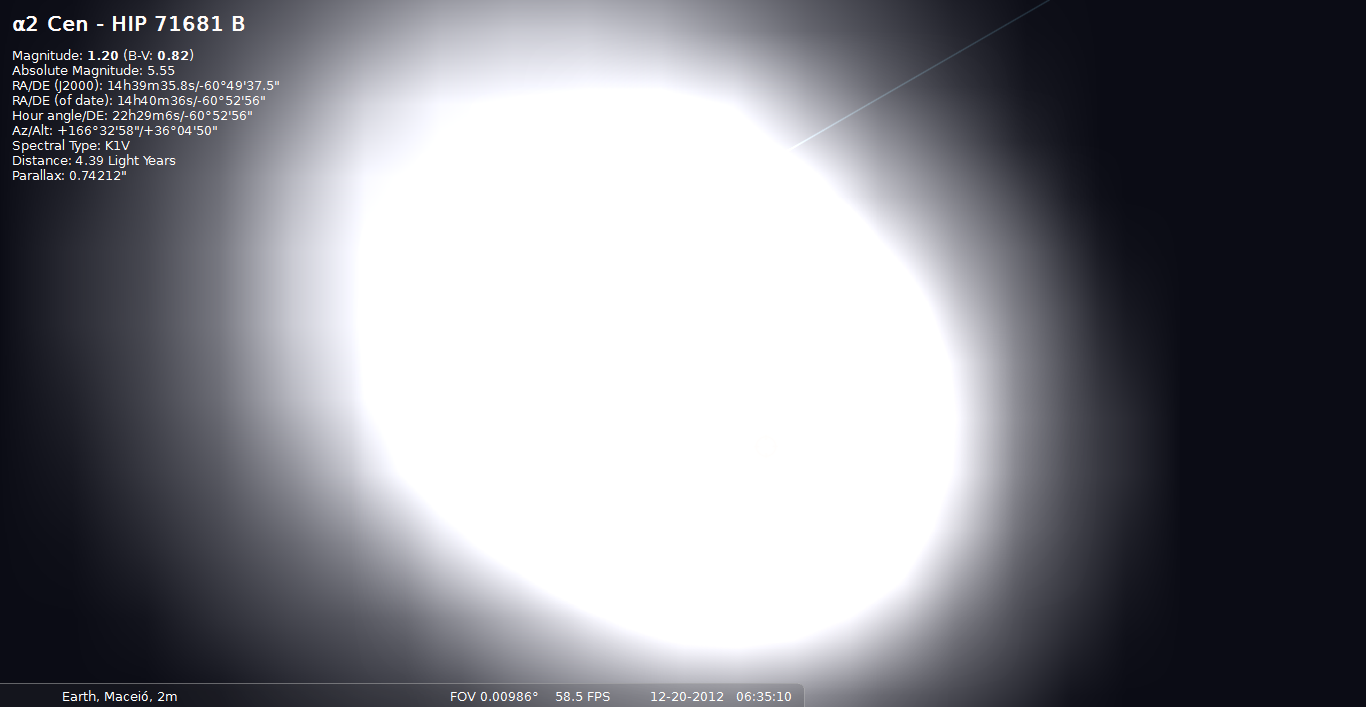
a1 Cen 12-20-12...
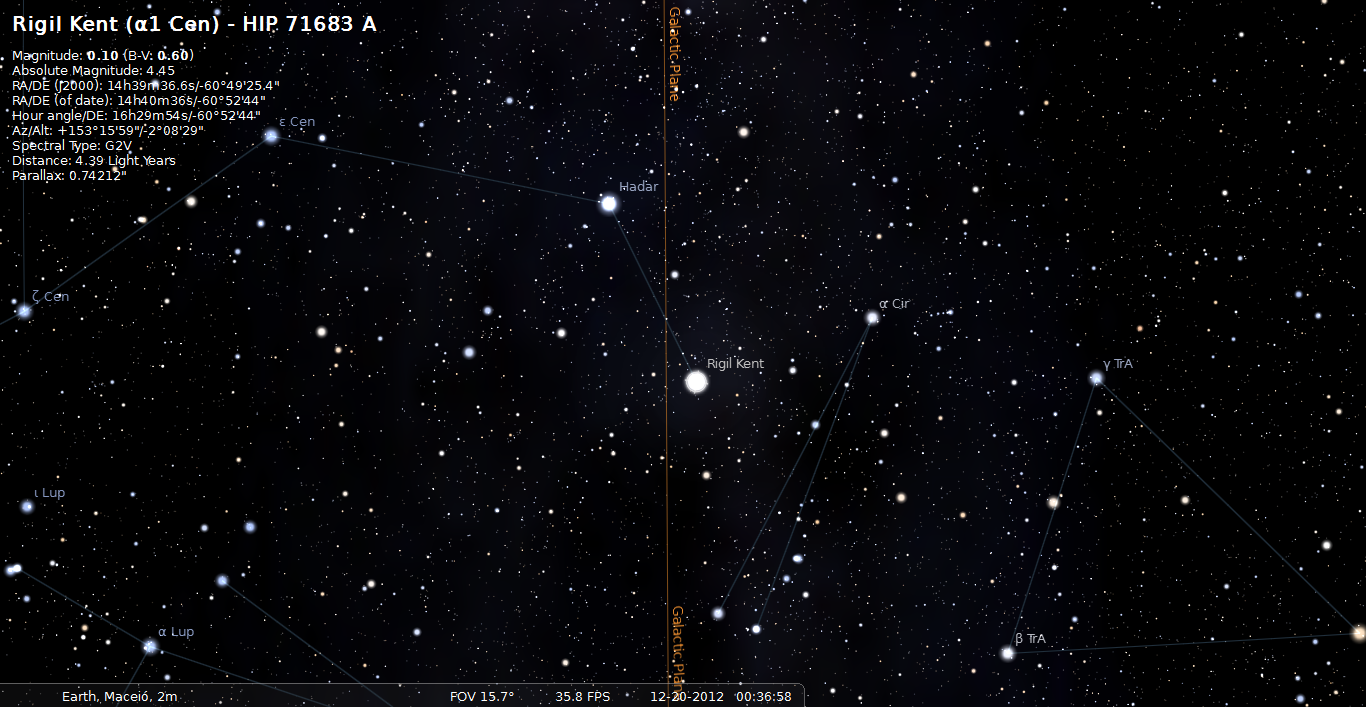
Both on 12-20-3115 BC...
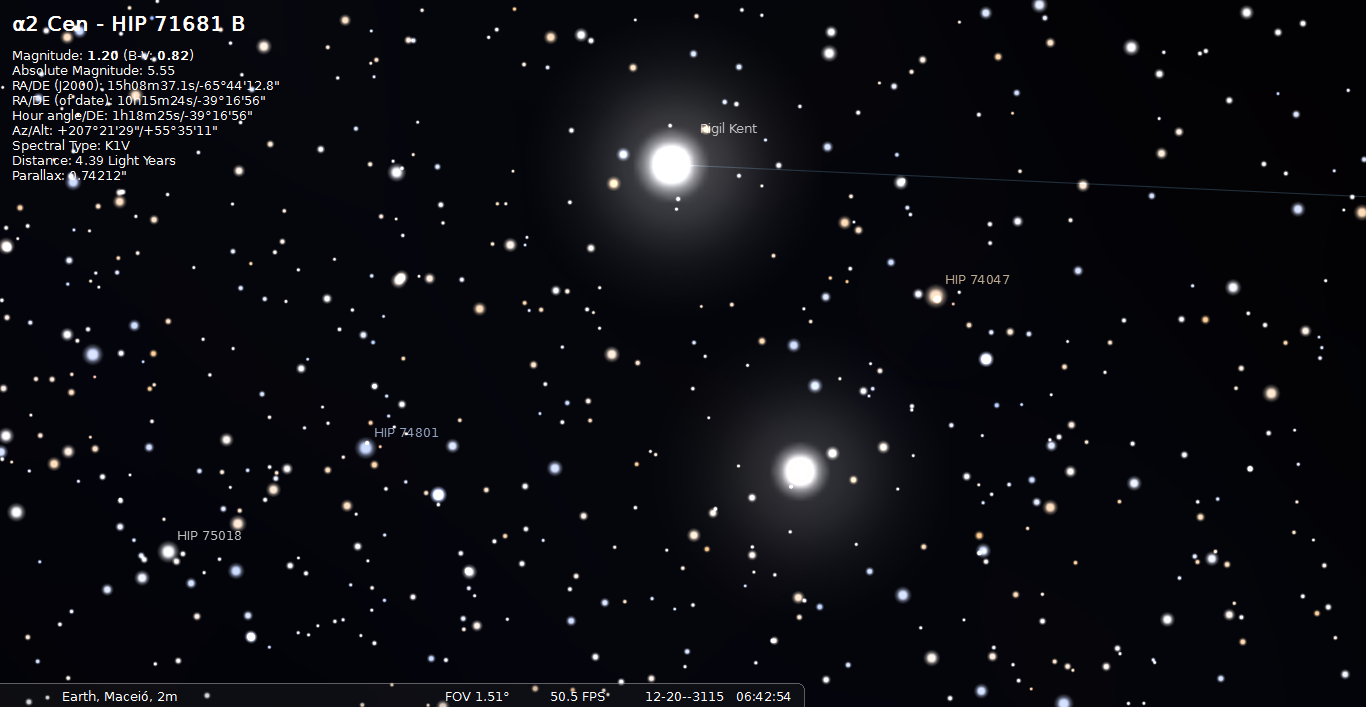
Both on 10-15-1475 (from the Sun)...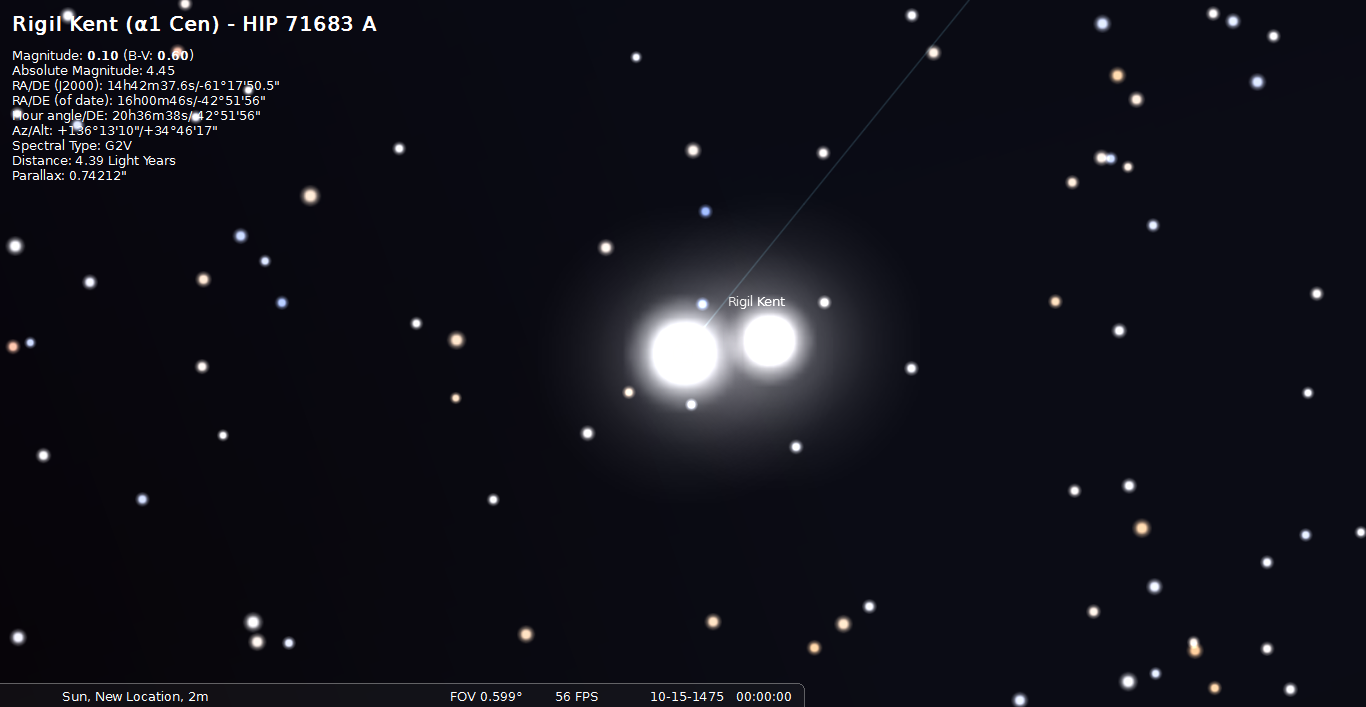
Both on 9-24-1550 (from the Sun)...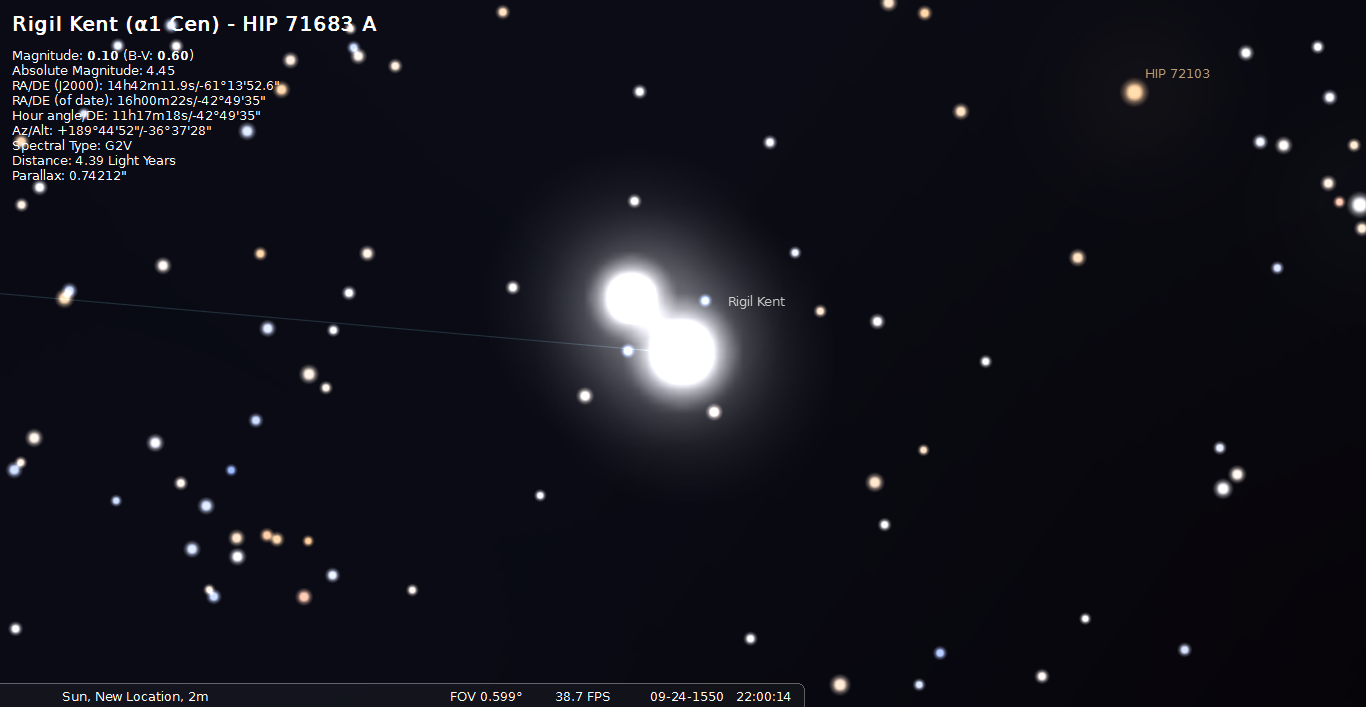
Both on 8-17-1662 (from the Sun)...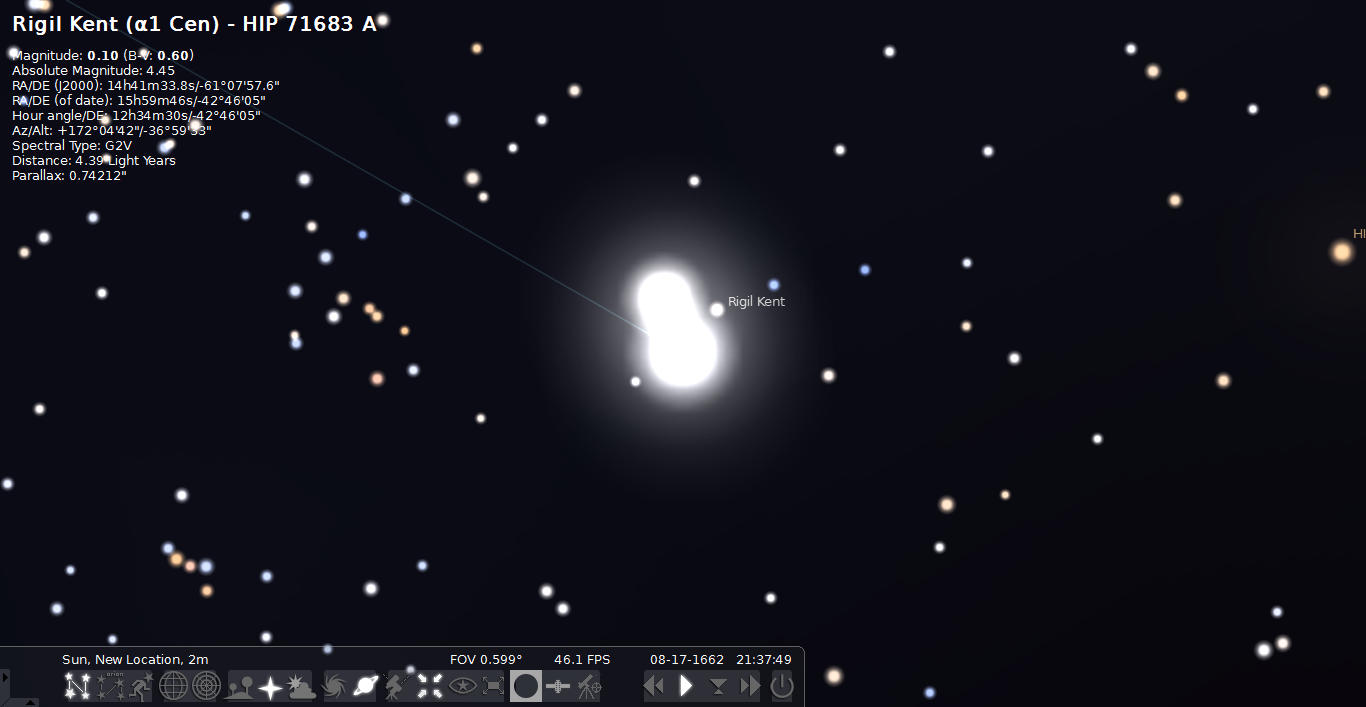
Both on 7-14-1989...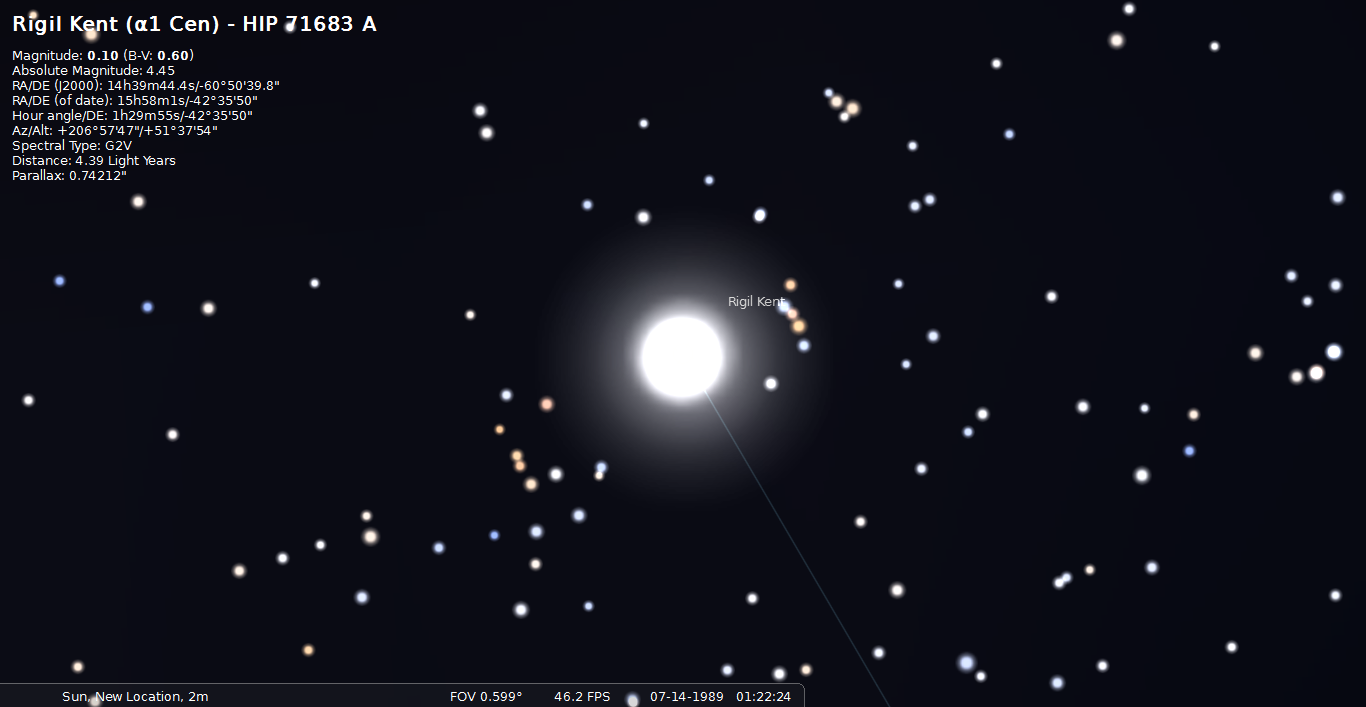
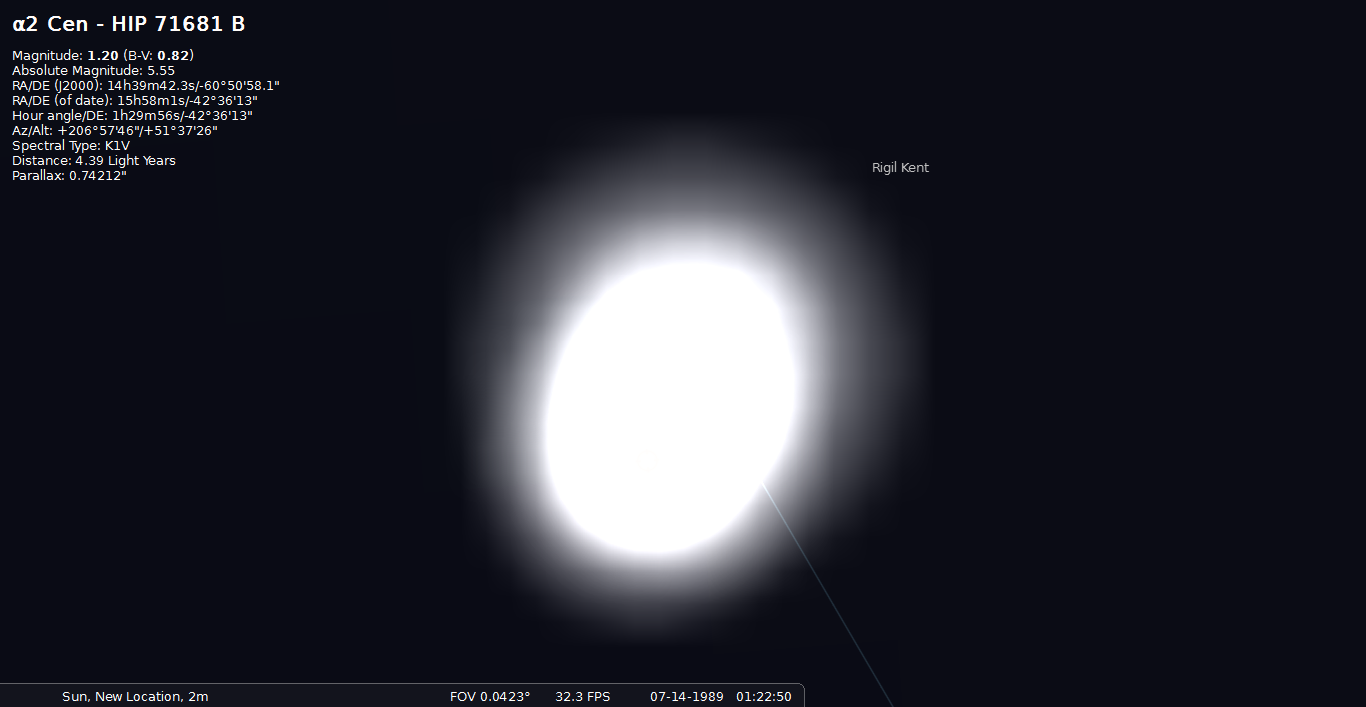
They are both the same distance, 4.39 LY and Today they have appeared to merge into one star. Rigil stays on the Galactic plane always. Which to me means that it is in the center of the Milky Way, I could be mistaken, I am not an astronomer. Our Sun does not stay on the galactic plane (crosses 2 times a year), but it seems to rotate around Rigil, for the purposes of this thread I will stay away from Sirius and Alcyone. Those happen to be my next topic and what I was actually looking at when I stumbled on to this.
Doesn't change from Earth or the Sun view.
BAW33
Now I am sure I will be told by someone how big a moron I am, but oh well...I took some pictures to share.
a2 Cen 12-20-12 (from the Earth)...


a1 Cen 12-20-12...


Both on 12-20-3115 BC...


Both on 10-15-1475 (from the Sun)...

Both on 9-24-1550 (from the Sun)...

Both on 8-17-1662 (from the Sun)...

Both on 7-14-1989...


They are both the same distance, 4.39 LY and Today they have appeared to merge into one star. Rigil stays on the Galactic plane always. Which to me means that it is in the center of the Milky Way, I could be mistaken, I am not an astronomer. Our Sun does not stay on the galactic plane (crosses 2 times a year), but it seems to rotate around Rigil, for the purposes of this thread I will stay away from Sirius and Alcyone. Those happen to be my next topic and what I was actually looking at when I stumbled on to this.
Doesn't change from Earth or the Sun view.
BAW33
edit on 12/20/2012 by BrokenAngelWings33 because: (no reason given)
Rigel Kent, better known as Alpha Centauri is a binary star system (2 stars, A and B).
There is also a third star that is part of the system known as Proxima
There is also a third star that is part of the system known as Proxima
reply to post by BrokenAngelWings33
I won't call you a moron, but even with all those pictures and your colorful text you failed to get a logical point across.
Isn't this the natural cycle?
Now I am sure I will be told by someone how big a moron I am, but oh well...I took some pictures to share.
I won't call you a moron, but even with all those pictures and your colorful text you failed to get a logical point across.
Isn't this the natural cycle?
edit on 12/20/2012 by Corruption Exposed because: (no reason given)
BTW - Just because you may not know a lot about a subject doesn't make you a "moron"
You found something that looked strange to you. Your brought it here and asked questions about it.
So it means you are curious and inquisitive.
You found something that looked strange to you. Your brought it here and asked questions about it.
So it means you are curious and inquisitive.
It's certainly cool to look at. And I don't think anyone is going to fault you for sharing cool stuff.
But as was stated, it is a binary system.
But please, no more blue text on the grey background. It makes my eyes wobbly.
But as was stated, it is a binary system.
But please, no more blue text on the grey background. It makes my eyes wobbly.
Originally posted by eriktheawful
BTW - Just because you may not know a lot about a subject doesn't make you a "moron"
You found something that looked strange to you. Your brought it here and asked questions about it.
So it means you are curious and inquisitive.
exactly. not all of us on ATS are bashers..most just want the truth..thats what i came here for
reply to post by eriktheawful
As well as an Earth-mass planet orbiting Alpha Centauri B (formally discovered just 2 months ago).
In addition to the info found in the Wikipedia article: A Planetary System Around Our Nearest Star is Emerging
Quite a complicated system.
As well as an Earth-mass planet orbiting Alpha Centauri B (formally discovered just 2 months ago).
In addition to the info found in the Wikipedia article: A Planetary System Around Our Nearest Star is Emerging
Quite a complicated system.
reply to post by CLPrime
I think over time we are going to find that planets around main sequence stars is pretty much the norm, and finding these kinds of stars without planets are the rarer breed.
I think over time we are going to find that planets around main sequence stars is pretty much the norm, and finding these kinds of stars without planets are the rarer breed.
reply to post by eriktheawful
It should certainly be the norm. Planets form from the accretion discs around proto-stellar formations. Since this is the norm for star formation, it would stand to reason that this norm would lead to the other norm -- that is, proto-stellar discs should normally (and naturally) give rise to planets.
Any star that does not have planets likely did at one time, but either swallowed them or ejected them at some point. At least, that would be my assumption.
It should certainly be the norm. Planets form from the accretion discs around proto-stellar formations. Since this is the norm for star formation, it would stand to reason that this norm would lead to the other norm -- that is, proto-stellar discs should normally (and naturally) give rise to planets.
Any star that does not have planets likely did at one time, but either swallowed them or ejected them at some point. At least, that would be my assumption.
edit on 21-12-2012 by CLPrime because: (no reason given)
reply to post by BrokenAngelWings33
First off, I think it's really cool that you're using Stellarium to help learn about the sky. I love that program!
Secondly, I'm glad you realize that the software (as a simulation) has its limits.
You have run up against one of these limits. In addition to the location in the sky, Stellarium also includes the stars' proper motion - that is, how far across the sky we see a star move in one year, and in which direction. Distance is an angle measured in arc seconds (1/3600 of a degree) - the Moon, for example is ~1800 arc seconds (or half a degree) as seen from Earth. Direction is an angle from celestial north.
One online reference for Rigil Kent lists a proper motion of 3.689 arcsec/yr (281.1° from north). At that rate, in the 5,126 years from -3115 to 2012, Alpha Centauri would move ~5.25 degrees across the sky.
However, it lists this for both component stars (A & B). I think that Stellarium entered the proper motion for A & B separately. I don't have time to dive into the Hipparcos Catalogue to find these numbers (I'm already late for meeting my family for lunch), but it's safe to assume that they are different, since the stars orbit each other every 80 years. Stellarium models orbits for objects within our solar system (planets, moons, comets, etc.), however for objects outside the solar system it just extrapolates stellar positions based on proper motion.
Thus, instead of showing Alpha Centauri A & B orbiting each other, it shows them moving in straight lines across the sky and diverging. Congratulations - You broke the system!
(Maybe you should ask for your money back. Oh yeah, it's free-ware.)
First off, I think it's really cool that you're using Stellarium to help learn about the sky. I love that program!
Secondly, I'm glad you realize that the software (as a simulation) has its limits.
You have run up against one of these limits. In addition to the location in the sky, Stellarium also includes the stars' proper motion - that is, how far across the sky we see a star move in one year, and in which direction. Distance is an angle measured in arc seconds (1/3600 of a degree) - the Moon, for example is ~1800 arc seconds (or half a degree) as seen from Earth. Direction is an angle from celestial north.
One online reference for Rigil Kent lists a proper motion of 3.689 arcsec/yr (281.1° from north). At that rate, in the 5,126 years from -3115 to 2012, Alpha Centauri would move ~5.25 degrees across the sky.
However, it lists this for both component stars (A & B). I think that Stellarium entered the proper motion for A & B separately. I don't have time to dive into the Hipparcos Catalogue to find these numbers (I'm already late for meeting my family for lunch), but it's safe to assume that they are different, since the stars orbit each other every 80 years. Stellarium models orbits for objects within our solar system (planets, moons, comets, etc.), however for objects outside the solar system it just extrapolates stellar positions based on proper motion.
Thus, instead of showing Alpha Centauri A & B orbiting each other, it shows them moving in straight lines across the sky and diverging. Congratulations - You broke the system!
(Maybe you should ask for your money back. Oh yeah, it's free-ware.)
new topics
-
God's Righteousness is Greater than Our Wrath
Religion, Faith, And Theology: 41 minutes ago -
Electrical tricks for saving money
Education and Media: 3 hours ago -
VP's Secret Service agent brawls with other agents at Andrews
Mainstream News: 5 hours ago -
Sunak spinning the sickness figures
Other Current Events: 5 hours ago -
Nearly 70% Of Americans Want Talks To End War In Ukraine
Political Issues: 5 hours ago -
Late Night with the Devil - a really good unusual modern horror film.
Movies: 7 hours ago -
Cats Used as Live Bait to Train Ferocious Pitbulls in Illegal NYC Dogfighting
Social Issues and Civil Unrest: 9 hours ago -
The Good News According to Jesus - Episode 1
Religion, Faith, And Theology: 11 hours ago
top topics
-
Florida man's trip overseas ends in shock over $143,000 T-Mobile phone bill
Social Issues and Civil Unrest: 16 hours ago, 8 flags -
Cats Used as Live Bait to Train Ferocious Pitbulls in Illegal NYC Dogfighting
Social Issues and Civil Unrest: 9 hours ago, 8 flags -
VP's Secret Service agent brawls with other agents at Andrews
Mainstream News: 5 hours ago, 8 flags -
Bobiverse
Fantasy & Science Fiction: 16 hours ago, 3 flags -
HORRIBLE !! Russian Soldier Drinking Own Urine To Survive In Battle
World War Three: 13 hours ago, 3 flags -
Electrical tricks for saving money
Education and Media: 3 hours ago, 3 flags -
Nearly 70% Of Americans Want Talks To End War In Ukraine
Political Issues: 5 hours ago, 3 flags -
Sunak spinning the sickness figures
Other Current Events: 5 hours ago, 3 flags -
Late Night with the Devil - a really good unusual modern horror film.
Movies: 7 hours ago, 2 flags -
The Good News According to Jesus - Episode 1
Religion, Faith, And Theology: 11 hours ago, 1 flags
active topics
-
VP's Secret Service agent brawls with other agents at Andrews
Mainstream News • 34 • : WeMustCare -
New whistleblower Jason Sands speaks on Twitter Spaces last night.
Aliens and UFOs • 53 • : pianopraze -
Sunak spinning the sickness figures
Other Current Events • 5 • : glen200376 -
SETI chief says US has no evidence for alien technology. 'And we never have'
Aliens and UFOs • 44 • : MikeDeGrasseTyson -
HORRIBLE !! Russian Soldier Drinking Own Urine To Survive In Battle
World War Three • 31 • : budzprime69 -
How ageing is" immune deficiency"
Medical Issues & Conspiracies • 33 • : rickymouse -
The Reality of the Laser
Military Projects • 46 • : Zaphod58 -
God's Righteousness is Greater than Our Wrath
Religion, Faith, And Theology • 0 • : randomuser2034 -
President BIDEN Vows to Make Americans Pay More Federal Taxes in 2025 - Political Suicide.
2024 Elections • 136 • : ImagoDei -
Electrical tricks for saving money
Education and Media • 3 • : Mike72
3
